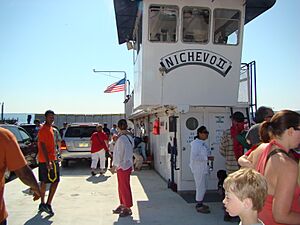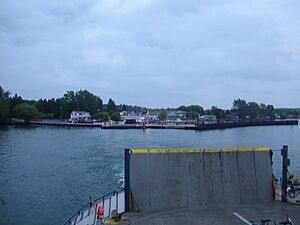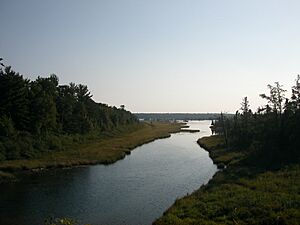Madeline Island facts for kids
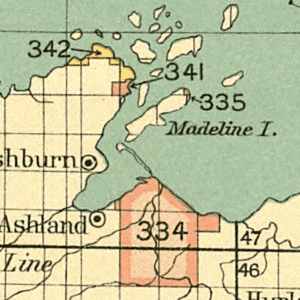
Madeline Island is a special island located in Lake Superior, in Ashland County, Wisconsin. It's been a very important spiritual place for the Lake Superior Chippewa people for a long time. Even though it's the biggest of the Apostle Islands, it's not part of the Apostle Islands National Lakeshore. This means it's the only island in the chain where people can own land and build businesses.
The town of La Pointe is on the western side of the island. It was started by French settlers as a place for trading furs. Today, about 302 people live there, but many more visit during the summer. You can get to the island by ferry from nearby Bayfield.
Contents
History
Madeline Island has always been a spiritual heartland for the Lake Superior Chippewa people. A traditional story from the Anishinaabeg (another name for the Ojibwe/Chippewa) says that the Great Spirit Gitche Manitou told them to travel west. They were told to go to a place where "food grows upon the water." They kept traveling until they found the wild rice that grew in the wet areas of nearby Chequamegon Bay.
Madeline Island got its name from Madeleine Cadotte, also known as Ikwesewe. She was the daughter of an Ojibwe chief named White Crane. Madeleine married a fur trader named Michel Cadotte. They were important leaders on the island in the 1800s. Native Americans, fur traders, and missionaries lived on the island for over 400 years. During that time, the flags of three different nations flew over it: France, Great Britain, and the United States.
Early Settlers and the Fur Trade
The island was first called Mooningwanekaaning, which means "At the Place Abundant with Yellow-shafted Northern flicker". For hundreds of years, it was home to the La Pointe Band of Lake Superior Chippewa, an Ojibwa group.
The first Europeans to settle here were French fur traders. In 1693, they built a fort, and the community of La Pointe grew around it. In the early 1800s, La Pointe became a key trading post for John Jacob Astor's American Fur Company, which started in 1808. Michel Cadotte, whose wife Ikwesewe (Madeline) was the chief's daughter, managed this post. The island was named after her. Marriages between traders and important Ojibwe women were common. These women helped their husbands succeed in trade by building trust and connecting them with Native American communities.
For 150 years, Madeline Island was a major hub for French, British, and American fur traders. They brought European goods to trade with Native Americans for furs. These furs were very popular in Europe.
Around 1660, two explorers and fur traders, Radisson and Groseilliers, came to Chequamegon Bay. They set up a French fur trading post on the island. From about 1660 to 1763, France and Great Britain competed fiercely in North America. They both wanted to control more fur-trading lands. As part of the Seven Years' War, British and French forces, along with their Native American allies, fought. When the British won, France gave up all its lands east of the Mississippi River.
After the War of 1812, Canadian traders were no longer allowed in U.S. territories. The fur trade on the island then came under the control of the American Fur Company. This company was founded by John Jacob Astor in 1808. By 1830, Astor had almost complete control of the fur trade in the United States. He became very rich and then left the fur trade to invest in real estate. The island's fur trading past is kept alive at the Madeline Island Historical Museum.
After the fur trade slowed down, other industries grew in the area. These included logging, commercial fishing, and brownstone quarrying. Brownstone from the Apostle Islands was used to build the first Milwaukee County Courthouse. Since the mid-1900s, the main industry on the island has been tourism.
Early Religious Missions

Around 1665, Jesuit priests Father Claude Allouez and Father Jacques Marquette arrived. They soon started a mission for the Ojibwe people. Later, in 1835, Father Frederic Baraga built a Catholic church on the island. This was at the site of the La Pointe Indian Cemetery. The original mission building is gone, but the old cemetery is still there. It is the burial place of Chief Buffalo, an important Chippewa leader.
Baraga's second Catholic mission on the island was built in 1838. It is on the same spot as the current St. Joseph's Catholic Church. This church has had a congregation since 1838, making it the oldest continuous Catholic parish in Wisconsin. The first church building burned down in 1901 and was rebuilt in 1902.
A Protestant mission, called "The Old Mission," started in 1832. Part of the original "Old Mission" dining room is now the La Pointe post office. This part was added to the Old Mission Inn in 1900 when it became a hotel. Today, the only Protestant church on the island is St. John's United Church of Christ, built in 1925. Because of its French past, many of the island's first churchgoers were Catholic. The Catholic church closes in winter. Most people who live on the island year-round attend St. John's UCC.
Native American Importance
The Ojibwe/Chippewa people who moved from eastern areas around the Great Lakes saw the island as a spiritual center.
In the 1800s, the island was home to Kechewaishke, or Chief Buffalo. He played a key role in stopping the U.S. government from moving the Chippewa people out of the region. He helped secure permanent reservations for them under the Treaty of La Pointe of 1854. Most of the Ojibwe on Madeline Island moved to the Bad River Reservation east of Ashland. Chief Buffalo was given land for his family on the mainland, just west of Madeline Island. This area is now known as the Red Cliff Indian Reservation. On the eastern end of Madeline Island, there is a small part of the Bad River Indian Reservation that is about 195 acres (0.79 km2).
Geography
The island is about 14 miles (21 km) long and three miles (5 km) wide. It's the only developed island among all the Apostle Islands. Other islands have lighthouses or small, preserved fishing villages, like Stockton Island or Raspberry Island.
The main town, La Pointe, Wisconsin, is on the southwestern tip of the island. Other small communities like Middleport and Old Fort are also on the island.
Madeline Island has a humid continental climate. This means it has warm summers and cold, snowy winters.
Transportation
You can reach the island by ferry and small aircraft during the warmer months. In winter, the ice on the lake usually gets too thick for the ferry. The last ferry trips of the season are typically in mid- to late January.
When the ice is strong enough, an ice road opens up. You can drive your car across the frozen lake from Bayfield to Madeline Island. This ice road is usually marked by Christmas trees and is an extension of County Highway H. If the ice is too thin for cars but too thick for the ferry, you can only get to the island by aircraft, snowmobile, or a special wind sled. The wind sled often runs in early winter and spring.
You can also get to the island by private boat or by hiring a private charter service. The island also has its own airport, called Major Gilbert Field Airport (4R5).
Education
The island has a school for children up to 5th grade. Students in middle school and high school go to school in Bayfield.
Tourism and Recreation
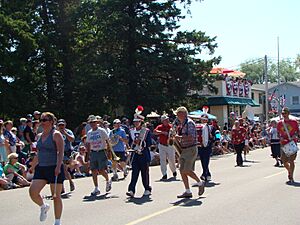
The main business on Madeline Island is tourism, especially in the summer. Because of its beautiful natural setting and many outdoor activities, the island is a popular vacation spot for people from the Midwest.
Activities
Many people enjoy hiking, biking, fishing, and sailing. You can rent bicycles and mopeds on the island. Kayaks and canoes are also available to rent, which you can use to explore the underwater caves and hollows along the cliffs. The island is known for its beaches on Lake Superior. Swimming isn't as common because the water is usually quite cold. However, the beaches are still popular in summer. The water in the sheltered bay can get up to 70°F (21°C), while the water just off shore might stay around 50°F (10°C).
The golf club has a course designed by Robert Trent Jones that features unique double greens.
The Apostle Islands Cruise Service offers boat tours of the Apostle Islands National Lakeshore. These tours include views of the historic Apostle Islands Lighthouses.
The Madeline Island Marathon and Half-Marathon takes place in May. The race starts and ends at Joni's Beach.
Accommodations
There are 60 campsites at Big Bay State Park. This 2,350-acre (9.5 km2) park is run by the Wisconsin Department of Natural Resources and is on the south-central shore of the island. The park is sometimes called Eagles' Nest because bald eagles build their nests in the tall pine trees on the cliffs. It has a large lagoon and a special bog/dune ecosystem.
Big Bay Town Park is next to the state park. It also offers camping and has access to the longest beach on the island.
Other places to stay on the island include a motel and rental cabins.
Sites of Interest
- The Madeline Island Historical Museum, run by the Wisconsin Historical Society, shows the island's history. The original museum is made of four old log buildings that were moved and joined together. It also has a newer part with historical items.
- La Pointe Indian Cemetery is next to the modern boat marina. It was started at the site of the first permanent Catholic mission on the island in 1835.
- The Ojibwe National Prayer Pole/Memorial Park is an area with sacred trees around a pond. It honors the special connection between the Ojibwe people and Madeline Island.
- A stone and brass plaque remembers the Michel Cadotte Fur Trading Post from 1792. It's on private land about two miles from the ferry dock.
- Joni's Beach is a public beach with picnic areas and a playground.
- Madeline Island Music Camp Clubhouse is a place where the International Music Camp holds performances.
In Popular Culture
Many legends and myths about the island have made it a mysterious place, especially around the Chequamegon Bay area. People are fascinated by the island's history, which helps these stories grow.
In the book Badger Boneyards: The Eternal Rest of the Story (2010), author Dennis McCann talks about the history of the La Pointe Indian Cemetery. He explains how it has sparked people's imaginations for many years. Some stories even mention rumors of paranormal activity, like spirits of Ojibwe people, linked to the cemetery.
The island has also been the setting for several novels, including Moon Over Madeline Island (2005) by Jay Gilbertson.
Riding the Wind is a musical show that tells the story of Bayfield and Old La Pointe through stories and songs. It has been performed at the Lake Superior Big Top Chautauqua, an outdoor music venue south of Bayfield.
A song by Owl City from the album Cinematic is about a camping trip on Madeline Island.
Notable Residents
- Michel Cadotte, an important fur trader in the 1800s. He was married to Ikewesewe, the Ojibwa woman for whom Madeline Island was named.
- Kechewaishke, (Ojibwa) a leader in the 1800s who helped get land set aside for Native Americans near Lake Superior.
- Thomas D. O'Brien, a Justice of the Minnesota Supreme Court.
- Ozhaguscodaywayquay, (Ojibwa), married John Johnston. They were a well-known trading family at Sault Ste. Marie. Their daughter, Jane Johnston, was the first Native American literary writer.
- William Whipple Warren, a historian of the Ojibwe people and a legislator in the Minnesota Territory. He had both Ojibwe and European-American family.


